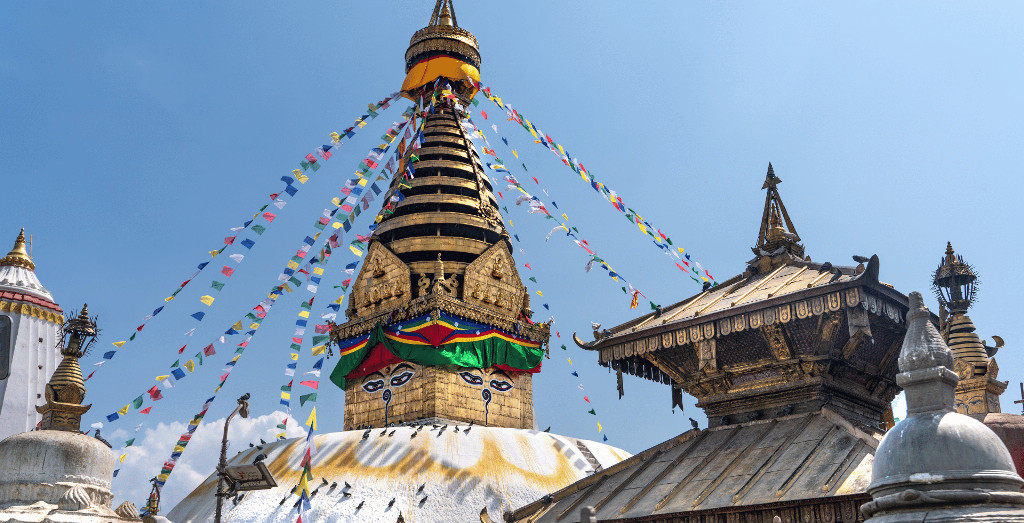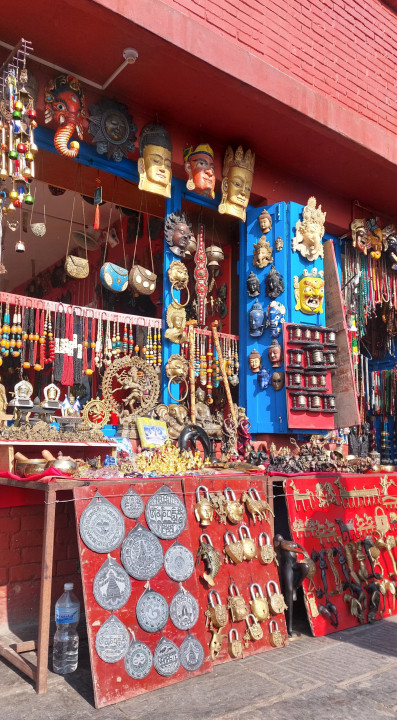
Sep 02 2025 | २०८२, भदौ १७ गते
Sep 02 2025 | २०८२, भदौ १७ गते

Diya Mittal
Kathmandu
Swayambhunath, a name that translates to "self-existent one" in Nepali, is more than just a landmark in Kathmandu. It's a 2,000-year-old monument perched atop a hillock, overlooking the bustling city and serving as a potent symbol of Nepal's religious harmony. Swayambhunath's significance transcends religious affiliation, drawing devotees and tourists alike, captivated by its unique blend of history, culture, and spirituality.
Legend narrates the valley's formation as a primordial lake from which a lotus flower bloomed, enshrining a radiant flame – the "Swayambhu." This eternal flame is said to be the source of the stupa's sanctity. Historical evidence, however, suggests the stupa's origins lie in the 2nd century BCE, pre-dating the arrival of Buddhism in the valley.
Early inscriptions from the 5th century AD credit King Manadeva with the stupa's construction, solidifying its importance as a Buddhist pilgrimage site. Swayambhunath's architectural marvel lies in the towering white dome symbolizing the earth, and the tiered superstructure representing the thirteen stages to enlightenment in Buddhism. The pinnacle features the all-seeing eyes of the Buddha gazing out in the four cardinal directions, a constant reminder of his teachings.
Despite its Buddhist roots, Swayambhunath exemplifies Nepal's religious inclusivity. Hindu shrines and deities seamlessly integrate into the complex. A prominent example is the temple dedicated to Manjusri, the Bodhisattva of wisdom, revered in both Buddhism and Hinduism. Similarly, the presence of a Shiva lingam and prayer flags, significant in Hinduism, underscore the site's significance for Hindu devotees.
 This harmonious co-existence is further emphasized by the resident monkeys, considered sacred by both religions. Legend associates them with Manjushri, who is said to have transformed his head lice into these playful creatures.
This harmonious co-existence is further emphasized by the resident monkeys, considered sacred by both religions. Legend associates them with Manjushri, who is said to have transformed his head lice into these playful creatures.
The monkeys of Swayambhunath, numbering around 200, are a unique feature of the complex. A 2019 study by the Tribhuvan University explored the human-wildlife relationship here. Researchers observed a complex dynamic, with pilgrims offering food and respecting the animals as sacred, while the monkeys sometimes exhibited aggressive behavior towards tourists.
The study highlights the challenges of managing a wildlife population within a religious site. The temple authorities have implemented measures like designated feeding zones and education campaigns to promote responsible interaction with the monkeys.
The climb to Swayambhunath is rewarded not just by spiritual immersion but also by a breathtaking panorama of Kathmandu. Standing atop the hillock, the city sprawls out before you, a vibrant tapestry of ancient temples, bustling markets, and snow-capped peaks framing the horizon. This elevated perspective allows visitors to appreciate the city's historical significance and its harmonious blend with the surrounding natural beauty.
Descending the steps, you'll find yourself amidst a vibrant bazaar overflowing with religious paraphernalia. Local shops, adorned with colorful prayer flags, offer an array of items catering to both Buddhist and Hindu pilgrims. Rows upon rows display prayer wheels intricately carved with mantras, incense sticks that fill the air with a calming fragrance, and statues depicting deities from both religions.
These shops aren't just commercial ventures; they're an extension of the spiritual experience at Swayambhunath. Devotees can purchase sacred offerings like marigolds and sindoor (vermilion powder) to present at the shrines. Thangka paintings, intricate tapestries depicting Buddhist deities and mandalas, are a popular choice for souvenirs, serving as a lasting reminder of the spiritual encounter. The friendly shopkeepers, many of whom are themselves devotees, are happy to answer questions and guide visitors through the significance of various religious items.
The sights, sounds, and smells of the bazaar surrounding Swayambhunath further immerse visitors in the rich tapestry of Kathmandu's religious life. It's a place where commerce and faith intertwine, creating a unique cultural experience that complements the spiritual significance of the monument itself.
Swayambhunath's enduring legacy is evident in its ability to withstand the test of time. The devastating earthquake of 2015 caused structural damage, but the monument's core remained intact. Reconstruction efforts, supported by international aid and local initiatives, are ongoing, ensuring its continued existence for future generations.
 Swayambhunath is more than a tourist destination; it's a microcosm of Nepal's rich cultural tapestry. A visit here offers a glimpse into the country's harmonious blend of Hinduism and Buddhism, its reverence for nature, and its unwavering spirit in the face of adversity. As you ascend the steps, the panoramic view of Kathmandu unfolds, a testament to the city's vibrant energy that mirrors the enduring spirit of Swayambhunath itself.
Swayambhunath is more than a tourist destination; it's a microcosm of Nepal's rich cultural tapestry. A visit here offers a glimpse into the country's harmonious blend of Hinduism and Buddhism, its reverence for nature, and its unwavering spirit in the face of adversity. As you ascend the steps, the panoramic view of Kathmandu unfolds, a testament to the city's vibrant energy that mirrors the enduring spirit of Swayambhunath itself.
© 2025 All right reserved to onlinepatrika.com | Site By : Sobij
© 2025 All right reserved to onlinepatrika.com | Site By : Sobij